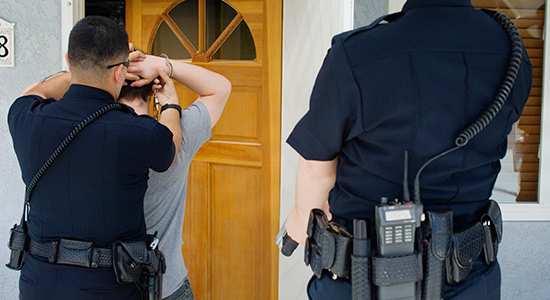
June 1, 2016 – Fifty years ago this month, on June 13, 1966, the U.S. Supreme Court decided Miranda v. Arizona.1 The decision is well-known for the warning that police must give to suspects before their interrogation.
It was a landmark decision insofar as it required an affirmative act on the part of police before a confession could be offered as evidence at trial.
The 5-4 decision was controversial at the time. Many in law enforcement feared that important confessions would be lost or that investigations would be hampered and criminals set free. Others hoped police and suspects would begin to operate on a level playing field. Time has shown that neither of these opposing views have become reality.
You Have the Right To …
Miranda has become embedded in routine police practice to the point where the warnings are part of our national culture. The warnings can be readily recited by most lawyers, even if they do not practice criminal law. The warning goes something like this:
You have the right to remain silent. Anything you say can and will be used against you in a court of law. You have the right to talk to a lawyer and have a lawyer present with you while you are being questioned. If you cannot afford to hire a lawyer, one will be appointed to represent you before any questioning if you wish. You can decide at any time to exercise these rights and not answer any questions or make any statements.
Miranda’s rule has found wide acceptance in the legal culture, the Supreme Court noted 34 years later, adding “[i]f anything, our subsequent cases have reduced the impact of the Miranda rule on legitimate law enforcement while reaffirming the decision’s core ruling that unwarned statements may not be used as evidence in the prosecution’s case in chief.2
Miranda stands as a landmark because it linked the Fifth Amendment’s privilege against self-incrimination to the Sixth Amendment’s guarantee of the right to counsel in order to protect a suspect’s rights from arrest through trial.
The Miranda majority’s suggestions about how to warn suspects subject to custodial interrogation were soon integrated into specific guidelines that were used in every state.
The Supreme Court recognized that coercion can be mental as well as physical, and that the blood of the accused is not the only hallmark of an unconstitutional inquisition.
Miranda followed many cases in which the Supreme Court reviewed the admissibility of confessions where a suspect was subjected to physical pain. But the Supreme Court recognized that coercion can be mental as well as physical, and that the blood of the accused is not the only hallmark of an unconstitutional inquisition.
“Interrogation still takes place in privacy,” Chief Justice Earl Warren wrote in Miranda. “Privacy results in secrecy and this in turn results in a gap in our knowledge as to what in fact goes on in the interrogation rooms.”3
Preventing Coercion
Police interrogation raises challenging legal questions because of important but competing interests: confessions aid police in solving crimes and promoting public safety; but the desire to obtain a confession can invite abusive police practices which undermine valued rights, and can prompt the innocent to confess.
 Marcus J. Berghahn, U.W. 1996, is a shareholder at Hurley, Burish & Stanton S.C., Madison. He represents individuals accused of misconduct and criminal wrongdoing in state and federal courts. He is also an adjunct professor at the U.W. Law School, where he teaches a seminars on the Fourth, Fifth and Sixth amendments and their Wisconsin counterparts. Reach by email or by phone at (608) 257-0945.
Marcus J. Berghahn, U.W. 1996, is a shareholder at Hurley, Burish & Stanton S.C., Madison. He represents individuals accused of misconduct and criminal wrongdoing in state and federal courts. He is also an adjunct professor at the U.W. Law School, where he teaches a seminars on the Fourth, Fifth and Sixth amendments and their Wisconsin counterparts. Reach by email or by phone at (608) 257-0945.
Miranda represents the Supreme Court’s attempt to balance these competing interests. The Supreme Court based its protective rule in the nature of modern police interrogation. These are “psychologically rather than physically oriented.”4
The goal is to isolate a suspect and deprive him or her of every psychological advantage and “to subjugate the individual to the will of the examiner.”5 Indeed, “the very fact of custodial interrogation exacts a heavy toll on individual liberty and trades on the weakness of individuals,” and “is at odds with one of our nation’s most cherished principles – that the individual cannot be compelled to incriminate himself.”6 Only the required warnings, the Court held, can dispel this inherent compulsion.
While the facts of Miranda did not show the defendant’s statements were involuntary in traditional terms, “the fact remains that in none of these cases did the officers undertake to afford appropriate safeguards at the outset of interrogation to insure that the statements were truly the product of free choice,” Chief Justice Warren wrote.
The four Miranda warnings supply these appropriate safeguards. The Supreme Court moved from a rule that barred coercive police conduct to a rule that requires the police to prevent coercion by giving a suspect specific legal warnings. Confessions were no longer admissible only because the police abstained from bad behavior.
Rather, after the ruling it became incumbent on police to affirmatively warn suspects of their right to remain silent and to have a lawyer. In the absence of these warnings, a court will presume the suspect’s statement was made involuntarily and it would be excluded from use at trial. But the suspect must affirmatively invoke his rights under Miranda. The right to silence can be waived through the suspect’s silence.
Learn More About Criminal Law
If you are headed to the State Bar’s Annual Meeting and Conference, June 16-17, in Green Bay, don’t miss the “Update on Wisconsin Criminal Law and Procedure” on day two. The panel includes Marquette University Law Professor Daniel Blinka, criminal defense attorney Rebecca Coffee (Mastantuono & Coffeee S.C.), Jefferson County District Attorney Susan Happ, and Walworth County Circuit Court Judge Phillip Koss.
Miranda’s Limits
Miranda changed police practices for sure, but it did little to interfere in the detection or prosecution of crimes because the decision does not stop police from interrogating suspects. Rather, the decision requires only that the suspect be apprised of his constitutional rights, right before an invitation to properly waive the rights.
After receiving a Miranda warning, police ask: “Do you understand these rights I have explained you? Having these rights in mind, do you wish to talk to us now?” In most cases, the suspect answers affirmatively. In so doing, the suspect waives these rights voluntarily, knowingly and intelligently. Such waiver need not be in writing.
The process of “Mirandizing” is very well known but its limits are actually less understood. Miranda does not apply to every contact between police and a suspect.
Certain predicates must exist before the rule (and its remedy exclusion) applies: evidence must have been gathered; the evidence must be testimonial; the evidence must have been obtained while the suspect was in custody and it must have been the product of interrogation, which was directed by state agents; and the evidence must be offered by the state in a criminal prosecution.
In most cases, police have learned to obtain inculpatory statements from the suspect before the suspect is placed into police custody. In that case, Miranda does not apply.
Legal challenges made in the interest of liberty and security have brought about court-approved modifications, including three exceptions: questions related to public safety (the ticking bomb scenario), routine booking questions, and the jail house informant.
Courts permit a suspect to re-initiate the interrogation process, even if he or she has not yet consulted with a lawyer. But after about two weeks, the police may re-initiate interrogation with the suspect. And even if the suspect remains in custody and is represented by a lawyer, the police may still seek to interrogate the suspect.
As long as the suspect waives his or her rights under Miranda, no Sixth Amendment violation interferes with the admissibility of the confession.
Conclusion
Miranda v. Arizona remains a significant constitutional decision that checks the power of the state to coerce confession. While it is not all things to all lawyers, the decision emphasizes the rights of citizens during police contacts, reinforces that police must follow those rights, and reinforced a commitment to the rule of law.
Endnotes
1 384 U.S. 436 (1966).
2 Dickerson v. United States, 530 U.S. 428, 443-44 (2000).
3 384 U.S. at 448 (internal citation omitted).
4 Id., at 450-51.
5 Id.
6 Id.
